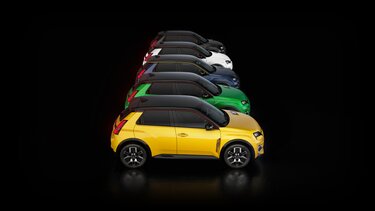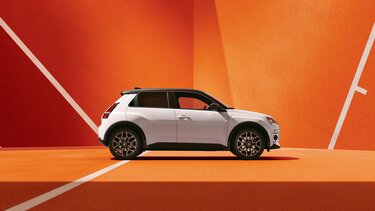E-Tech innovations that are changing the car industry
21/11/2025
The automotive industry is undergoing the biggest transformation in its history. Over the past decade, we’ve seen an accelerating shift from traditional petrol and diesel engines to hybrid and fully electric cars. But it isn’t just about replacing one type of powertrain with another – it’s about a suite of innovations that are redefining how we think about driving, ownership and the future of mobility.
Renault has long been at the forefront of this change. From the early days of the electric Zoe, through to today’s comprehensive Renault electric vehicles and E-Tech hybrid range, the French brand has consistently pushed the boundaries of what’s possible. Its latest E-Tech innovations combine advanced engineering with smart technology, offering drivers more efficiency, more performance and more choice.
So, what are the innovations driving this change – and how exactly do electric cars work in practice? Let’s take a closer look.
Hybrid and electric powertrains: the best of both worlds
Ask most drivers about E-Tech and they’ll tell you it’s all about the powertrain. That’s true, but Renault’s take on electrification goes deeper than simply swapping an engine for a battery.
Renault’s E-Tech hybrid and plug-in hybrid technology blends electric motors with petrol engines. The clever part is the multi-mode gearbox, which ensures seamless switching between power sources. In practice, that means you get electric driving at low speeds and in stop-start traffic, but with the reassurance of petrol power for longer journeys.
For many buyers, it’s a stepping stone, a way to experience electric mobility without having to worry about charging. And when you’re ready to take the full step into electric driving, Renault’s E-Tech EVs – from the Renault 5 E-Tech electric to the Megane E-Tech electric show exactly how electric cars work in everyday life. With instant torque, smooth acceleration and quieter running, the experience is not only efficient but genuinely enjoyable.
Regenerative braking: turning energy into range
One of the most talked-about features of modern electric car technology is regenerative braking. Instead of losing energy as heat every time you slow down, E-Tech cars capture that power and feed it back into the battery.
It sounds simple, but the impact is huge. In city driving, where you’re frequently braking and accelerating, regenerative braking can extend your range significantly. Renault has honed this system so that it feels natural and intuitive, where lifting off the accelerator slows the car enough for most braking situations, while still sending power back into the battery. On Renault 4, Megane and Scenic, this allows for full One Pedal driving, slowing to a complete stop.
Regenerative Braking, once a novelty, is now a must-have feature of electric mobility. And it’s one of the areas where Renault’s experience counts, having spent years developing and refining regenerative systems across its hybrid and electric line-up.
Artificial intelligence: smarter, safer, more efficient
If powertrains are the heart of E-Tech, then artificial intelligence is fast becoming the brain. Modern cars are rolling computers, gathering vast amounts of data every second – and AI is increasingly the key to making sense of it all.
Renault is investing heavily in this space. As outlined in Renault Group’s AI strategy, the focus is on using artificial intelligence to improve energy efficiency, optimise battery charging and even help enhance driver safety.
Charging technology: faster, easier, more accessible

One of the biggest questions potential EV buyers ask is: how fast does it charge? Renault’s E-Tech cars are designed to deliver the best possible balance between speed, efficiency and battery longevity.
Fast-charging capability means you can add significant range in a short stop – often enough to charge from 15-80% in around 30 minutes*, depending on the model and charging station. Meanwhile, home charging remains the most practical option for many. Renault is keen to highlight the financial support available, with details on the latest electric car grants for buyers looking to make the switch.
As charging infrastructure expands rapidly across the UK and Europe, this combination of home convenience and public fast charging is helping to make electric mobility mainstream.
A new era of automotive design
It isn’t just the technology under the skin that’s changing – design is evolving too. Electric cars don’t need traditional grilles or bulky engine bays, freeing up designers to create bold new looks and more practical interiors.
The Renault 5 E-Tech electric and Renault 4 E-Tech electric models are perfect examples. Inspired by classic Renaults but reimagined for the future, they combine retro charm with modern aerodynamics and clever packaging. Inside, the flat-floor layout made possible by the electric battery pack gives more room for passengers and luggage, while large touchscreens and advanced connectivity bring digital convenience to every journey.
This shift in design thinking is part of a broader trend in automotive innovation, where cars are becoming more than just vehicles – they’re connected, adaptable spaces for work, rest and play.
The future of mobility: choice and confidence
So where does this leave drivers today? The good news is that choice has never been greater. Whether you’re looking for a hybrid family car, a compact city EV or a stylish SUV, Renault’s E-Tech range covers all bases.
Just as importantly, Renault offers support throughout the ownership journey – from attractive offers on new models to innovative services that make charging and running costs more predictable.
For those still weighing up the switch, the message is clear: automotive innovation is no longer about futuristic concepts. It’s here, now, in the cars we can buy today. Renault’s E-Tech technology demonstrates that the future of mobility isn’t something to wait for – it’s something you can drive home in right now.
E-Tech innovations are transforming the auto industry in ways that go far beyond engines and batteries. From regenerative braking to new approaches in design and ownership, the pace of change is extraordinary.
Renault has played a leading role in this revolution, blending its experience in hybrids with bold new electric models and forward-thinking services. By making electric mobility smarter, more accessible and more rewarding to drive, Renault is showing exactly what the future of mobility looks like.
And the best part? It’s only just beginning.
*Charging time may vary depending on charging conditions, including charger type and condition, on-site power usage, battery temperature as well as ambient temperature at point of use, battery age and state of charge, and if battery safeguarding technology is activated. Visit MyRenault for coverage details.
About the author
Steve is a leading UK automotive journalist, EV editor at The Independent, editor of Auto Express, Autocar and What Car?, and a global car awards judge and broadcaster.
This article is advertorial content reviewed by Renault prior to publication.
get the latest Renault news







